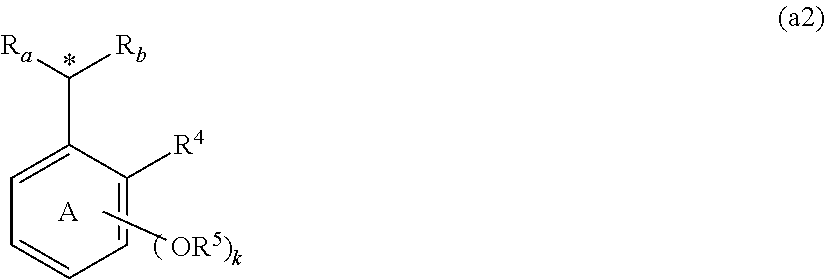Production method of oligonucleotide
a production method and oligonucleotide technology, applied in the field of oligonucleotide production method, can solve the problems of limited scaling up, difficult analysis of intermediate structure and the like, and difficult rapid synthesis of long oligonucleotides, and achieve the effect of high yield
- Summary
- Abstract
- Description
- Claims
- Application Information
AI Technical Summary
Benefits of technology
Problems solved by technology
Method used
Image
Examples
reference example 1
Synthesis of 3,4,5-tris(octadecyloxy)benzyl amine
[0259]
(1) Synthesis of 3,4,5-tris(octadecyloxy)benzyl chloride
[0260]Under an argon atmosphere, 3,4,5-tris(octadecyloxy)benzyl alcohol (10.0 g, 11.0 mmol) was dissolved in dichloromethane (100 mL), N,N-dimethylformamide (84.0 μL, 1.10 mmol) and thionyl chloride (1.20 ml, 16.4 mmol) were added, and the mixture was stirred at 30° C. for 90 min. After completion of the reaction, the reaction mixture was concentrated under reduced pressure, acetonitrile was added, and the precipitated solid was filtered. The obtained solid was dried under reduced pressure to give the title compound (10.0 g, 98.2%) as a white solid.
(2) Synthesis of 3,4,5-tris(octadecyloxy)benzyl azide
[0261]3,4,5-Tris(octadecyloxy)benzyl chloride (4.02 g, 4.31 mmol) was dissolved in a mixed solvent of chloroform (40 mL) and N,N-dimethylformamide (120 mL), sodium azide (418 mg, 6.42 mmol) was added, and the mixture was stirred at 80° C. for 3 hr. After completion of the react...
reference example 2
Synthesis of 3,5-bis(docosyloxy)benzyl alcohol
[0265]
(1) Synthesis of methyl [3,5-bis(docosyloxy)]benzoate
[0266]Potassium carbonate (19.9 g, 144 mmol) was suspended in dehydrating N,N-dimethylformamide (200 mL), 1-bromodocosane (15.6 g, 46.7 mmol) and methyl (3,5-dihydroxy)benzoate (3.60 g, 21.4 mmol) were added, and the mixture was stirred at 90° C. overnight. After completion of the reaction, the reaction mixture was poured into purified water (800 mL), the mixture was stirred for 1 hr, and the precipitated solid was collected by filtration. The obtained solid was dissolved again in dichloromethane (800 mL), and the insoluble material was filtered off. The filtrate was concentrated under reduced pressure, and acetone was added again to precipitate a solid. The solid was collected by filtration and slurry-washed in methanol. After filtration, the obtained solid was dried under reduced pressure to give the title compound (13.9 g, 96.5%) as a white solid.
(2) Synthesis of 3,5-bis(docos...
reference example 3
Synthesis of 3,5-bis(docosyloxy)benzyl amine
[0270]
[0271]The title compound was synthesized from 3,5-bis(docosyloxy)benzyl alcohol according to the method of Reference Example 1.
[0272]TLC: Rf=0.50 (dichloromethane:hexane=1:4)
[0273]1H-NMR (400 MHz): δ 0.88 (t, 6H, J=7.0 Hz, H3C-docosyloxy), 1.25-1.79 (m, 84H, —CH2-docosyloxy), 3.79 (s, 2H, H2N—CH2-benzyl), 3.93 (t, 4H, J=6.6 Hz, —O—CH2-docosyloxy), 6.34 (s, 1H, -benzyl), 6.44 (s, 2H, -benzyl)
PUM
| Property | Measurement | Unit |
|---|---|---|
| Polarity | aaaaa | aaaaa |
| Acidity | aaaaa | aaaaa |
Abstract
Description
Claims
Application Information
 Login to View More
Login to View More - R&D
- Intellectual Property
- Life Sciences
- Materials
- Tech Scout
- Unparalleled Data Quality
- Higher Quality Content
- 60% Fewer Hallucinations
Browse by: Latest US Patents, China's latest patents, Technical Efficacy Thesaurus, Application Domain, Technology Topic, Popular Technical Reports.
© 2025 PatSnap. All rights reserved.Legal|Privacy policy|Modern Slavery Act Transparency Statement|Sitemap|About US| Contact US: help@patsnap.com



